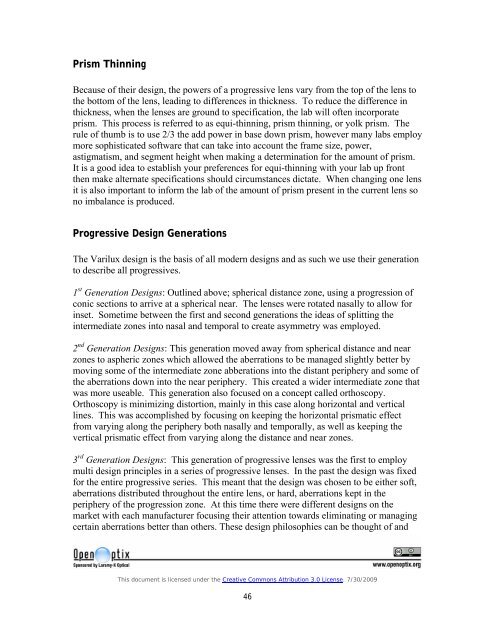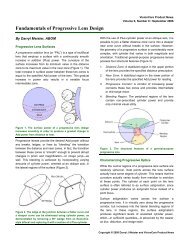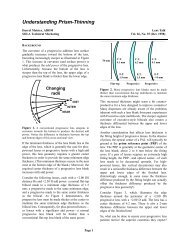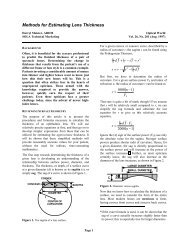OpenOptix ABO Study Guide - Laramy-K Optical
OpenOptix ABO Study Guide - Laramy-K Optical
OpenOptix ABO Study Guide - Laramy-K Optical
Create successful ePaper yourself
Turn your PDF publications into a flip-book with our unique Google optimized e-Paper software.
Prism Thinning<br />
Because of their design, the powers of a progressive lens vary from the top of the lens to<br />
the bottom of the lens, leading to differences in thickness. To reduce the difference in<br />
thickness, when the lenses are ground to specification, the lab will often incorporate<br />
prism. This process is referred to as equi-thinning, prism thinning, or yolk prism. The<br />
rule of thumb is to use 2/3 the add power in base down prism, however many labs employ<br />
more sophisticated software that can take into account the frame size, power,<br />
astigmatism, and segment height when making a determination for the amount of prism.<br />
It is a good idea to establish your preferences for equi-thinning with your lab up front<br />
then make alternate specifications should circumstances dictate. When changing one lens<br />
it is also important to inform the lab of the amount of prism present in the current lens so<br />
no imbalance is produced.<br />
Progressive Design Generations<br />
The Varilux design is the basis of all modern designs and as such we use their generation<br />
to describe all progressives.<br />
1 st Generation Designs: Outlined above; spherical distance zone, using a progression of<br />
conic sections to arrive at a spherical near. The lenses were rotated nasally to allow for<br />
inset. Sometime between the first and second generations the ideas of splitting the<br />
intermediate zones into nasal and temporal to create asymmetry was employed.<br />
2 nd Generation Designs: This generation moved away from spherical distance and near<br />
zones to aspheric zones which allowed the aberrations to be managed slightly better by<br />
moving some of the intermediate zone abberations into the distant periphery and some of<br />
the aberrations down into the near periphery. This created a wider intermediate zone that<br />
was more useable. This generation also focused on a concept called orthoscopy.<br />
Orthoscopy is minimizing distortion, mainly in this case along horizontal and vertical<br />
lines. This was accomplished by focusing on keeping the horizontal prismatic effect<br />
from varying along the periphery both nasally and temporally, as well as keeping the<br />
vertical prismatic effect from varying along the distance and near zones.<br />
3 rd Generation Designs: This generation of progressive lenses was the first to employ<br />
multi design principles in a series of progressive lenses. In the past the design was fixed<br />
for the entire progressive series. This meant that the design was chosen to be either soft,<br />
aberrations distributed throughout the entire lens, or hard, aberrations kept in the<br />
periphery of the progression zone. At this time there were different designs on the<br />
market with each manufacturer focusing their attention towards eliminating or managing<br />
certain aberrations better than others. These design philosophies can be thought of and<br />
This document is licensed under the Creative Commons Attribution 3.0 License. 7/30/2009<br />
46









